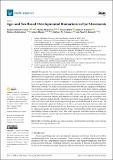| dc.contributor.author | Carrick, Frederick Robert | |
| dc.contributor.author | Hunfalvay, Melissa | |
| dc.contributor.author | Bolte, Takumi | |
| dc.contributor.author | Azzolino, Sergio F. | |
| dc.contributor.author | Abdulrahman, Mahera | |
| dc.contributor.author | Hankir, Ahmed | |
| dc.contributor.author | Antonucci, Matthew M. | |
| dc.contributor.author | Al-Rumaihi, Nouf | |
| dc.date.accessioned | 2025-01-10T21:50:56Z | |
| dc.date.available | 2025-01-10T21:50:56Z | |
| dc.date.issued | 2024-12-21 | |
| dc.identifier.uri | https://hdl.handle.net/1721.1/157960 | |
| dc.description.abstract | Background: Eye movement research serves as a critical tool for assessing brain function, diagnosing neurological and psychiatric disorders, and understanding cognition and behavior. Sex differences have largely been under reported or ignored in neurological research. However, eye movement features provide biomarkers that are useful for disease classification with superior accuracy and robustness compared to previous classifiers for neurological diseases. Neurological diseases have a sex specificity, yet eye movement analysis has not been specific to our understanding of sex differences. Methods: The study involved subjects recruited from 804 sites equipped with RightEye Vision Systems, primarily located in optometry practices across the United States. Subjects completed six eye movement assessments: circular smooth pursuit (CSP), horizontal smooth pursuit (HSP), vertical smooth pursuit (VSP), horizontal saccades (HS), vertical saccades (VS), and fixation stability (FS). Eye movements were analyzed and classified in accordance with age and sex by multiple t-tests and linear regression models. Results: This study represented a large sample size of 23,557 subjects, with 11,871 males and 11,686 females representing ages from birth through 80 years of age. We observed statistically significant differences for all eye movement functions between males and females. Conclusions: We demonstrate that eye movements are sex-specific and offer normative data to compare sex-specific eye movement function by age. Novel baseline metrics can be compared to individual performance, regardless of sex. This study represents significant progress in linking eye movements with brain function and clinical syndromes, allowing researchers and clinicians to stratify individuals by age and sex. | en_US |
| dc.publisher | Multidisciplinary Digital Publishing Institute | en_US |
| dc.relation.isversionof | http://dx.doi.org/10.3390/brainsci14121288 | en_US |
| dc.rights | Creative Commons Attribution | en_US |
| dc.rights.uri | https://creativecommons.org/licenses/by/4.0/ | en_US |
| dc.source | Multidisciplinary Digital Publishing Institute | en_US |
| dc.title | Age- and Sex-Based Developmental Biomarkers in Eye Movements | en_US |
| dc.type | Article | en_US |
| dc.identifier.citation | Carrick, F.R.; Hunfalvay, M.; Bolte, T.; Azzolino, S.F.; Abdulrahman, M.; Hankir, A.; Antonucci, M.M.; Al-Rumaihi, N. Age- and Sex-Based Developmental Biomarkers in Eye Movements. Brain Sci. 2024, 14, 1288. | en_US |
| dc.contributor.department | Massachusetts Institute of Technology. Department of Biological Engineering | en_US |
| dc.relation.journal | Brain Sciences | en_US |
| dc.identifier.mitlicense | PUBLISHER_CC | |
| dc.eprint.version | Final published version | en_US |
| dc.type.uri | http://purl.org/eprint/type/JournalArticle | en_US |
| eprint.status | http://purl.org/eprint/status/PeerReviewed | en_US |
| dc.date.updated | 2024-12-27T14:02:59Z | |
| dspace.date.submission | 2024-12-27T14:02:59Z | |
| mit.journal.volume | 14 | en_US |
| mit.journal.issue | 12 | en_US |
| mit.license | PUBLISHER_CC | |
| mit.metadata.status | Authority Work and Publication Information Needed | en_US |
